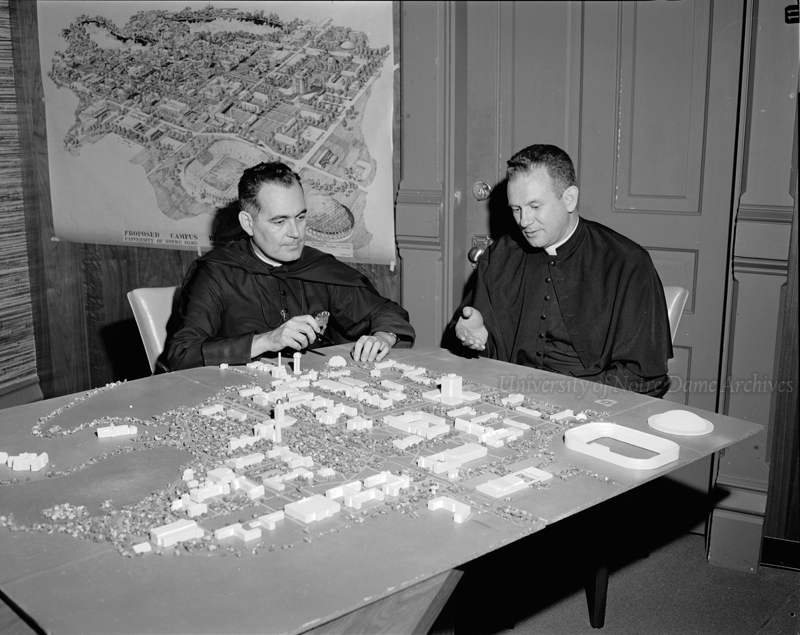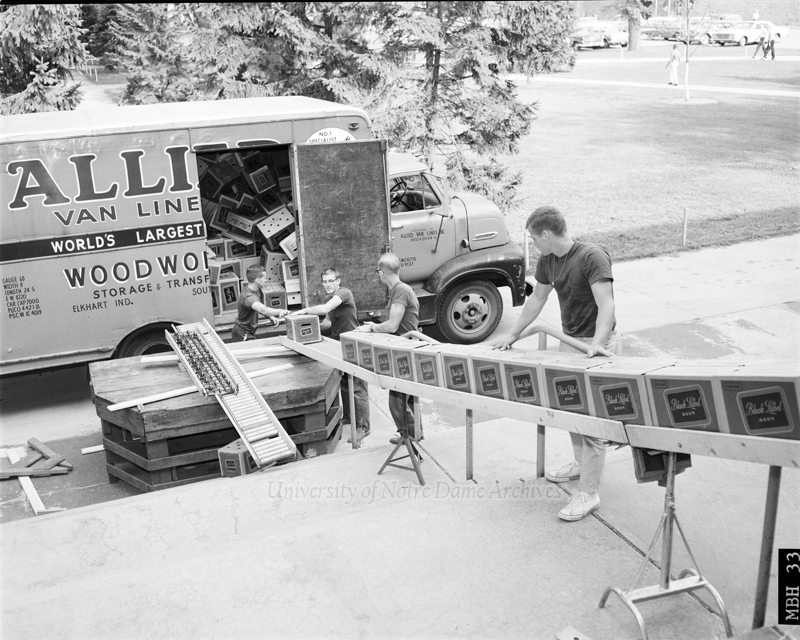 Caption
Caption
Source: University of Notre Dame Archives.
The Library: Planning
The First Libraries
The University of Notre Dame was founded in 1842, but it would be another thirty-one years before it officially had its own library. The University library was conceived by Rev. Augustus Lemonnier, C.S.C., the fourth president of the University, in 1872, and a circulating library was opened in the Main Building in 1873. In the next 6 years, the library collection grew to 10,000 volumes.
In 1879 a great fire destroyed the original Main Building and the library. Students were able to salvage about 500 books. There was a huge outpouring of support from friends and alumni of Notre Dame, and the collection quickly grew from donations. Within a year, it was up to 3,200 volumes. Within three years (1882), it surpassed 16,000, and was then moved to the newly finished Main Building. In 1886, it was up to 26,000, then 40,000 in 1890, and 55,000 by 1900.
In 1917, the University built the Lemonnier Library, which is now Bond Hall. It was built to house 618,000 books, which at the time seemed large enough, given the current collection was just under 100,000. However, in the next 40 years, the collection began to outgrow the building. Long before Father Hesburgh took the helm at Notre Dame in 1952, there was a clear need for a new library.
Fundraising
In 1958, Father Hesburgh revealed to the public that a new library would be slated for campus development. In 1959, plans began to take shape, and details of the new library were formally announced. The plan included open stacks, the capacity for two million books, and seating for about three thousand, or half the student body at the time. There was much excitement on campus, which was no surprise considering the state of the current Lemonnier Library, as described in an editorial in the Notre Dame Scholastic.
It takes but a few minutes in the present library to see the sorry state of the 'heart' of our University. The books are shelved far away in that nebulous place known as the stacks. Most students ordering books from the card catalogue have often wondered if that index was a list of books the University had or wanted to buy.
Planning and Construction
The planning committee chose a spot on the east side of campus, north of the football stadium. The site was a large stretch of land, which then contained the Navy drill hall, Cartier Field, and Vetville housing for young World War II veteran students and their families. Father Hesburgh and Father Joyce, the executive vice president, agreed that the library should be one of the three main focal points on campus, to emphasize the importance placed on scholarship. The Church of the Sacred Heart (the present day Basilica) would remain the highest point at Notre Dame, and the new library roof would be roughly level with the statue of Our Lady on the dome of the Main Building.
The University chose Ellerbe and Co., of St. Paul, Minnesota, as the architectural firm, which had designed several other buildings on campus: O'Shaughnessy Hall of Liberal and Fine Arts, the Art Gallery and the Sculpture Studio, and Keenan and Stanford Halls. Ellerbe and Co. drew up plans for a 14-story library with a two-acre footprint, which would not only be the largest structure on campus, but among the largest university libraries in the world.

Source: University of Notre Dame Archives.
As fundraising efforts continued, the land was cleared and ground prepared in the summer of 1961. In August, the University held a formal ceremony during which Father Hesburgh blessed the site of the new library. The following April was the "topping out" ceremony, at which the last and highest beam was raised and set atop the steel framework of the library. Father Hesburgh signed the steel girder with the Latin inscription, "Nos cum prole pia, benedicat Virgo Maria." The Medieval Franciscan prayer translates to "May the virgin Mary bless us with her loving child." Father Hesburgh later said of the building that "it was a great act of faith," as it was by far their largest undertaking to date, and construction had begun prior to reaching their fundraising goal.
In August, a month before the opening, in a well orchestrated system supervised by several librarians, around a half million books were packaged by student volunteers into Carling Black Label Beer cases, set onto a temporary conveyor belt system out of Lemonnier Library, loaded into moving vans, and driven over to the new building. They were then shelved in a similarly organized, yet much more complicated process, given the larger size of the building and different floor plan. The new Memorial Library was nearly complete.

Source: University of Notre Dame Archives.